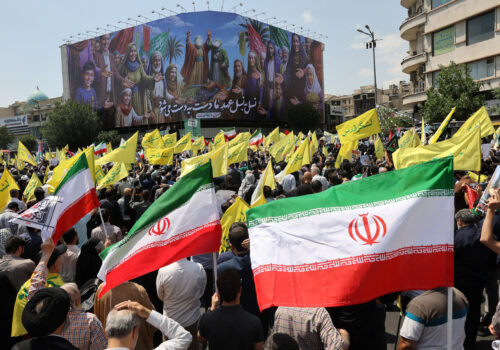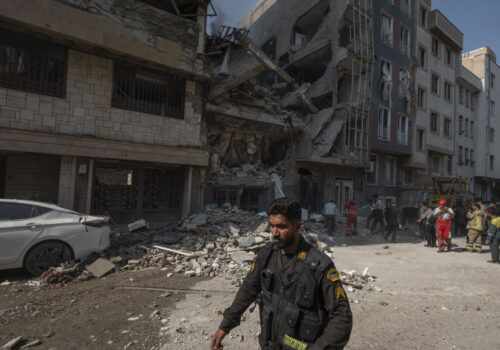How the US can reduce the risk of wider war in the Middle East
Israel has again demonstrated an uncanny ability to rewrite the regional playbook with a multi-pronged, multi-day attack on Iran’s nuclear program, air defenses, and military leadership. The first phase of attacks in particular—strikes at the heart of Iran’s nuclear and missile programs, the decapitation of the Islamic Revolutionary Guard Corps’ (IRGC) Quds Force leadership, and nuclear scientists—caused many to marvel at the boldness of David against Goliath.
As the Trump administration navigates this chapter, the key will be to contain and defuse the situation as the regional players sort through the changed landscape. De-escalation in the near term is not a foregone conclusion. It will require heavy lifting from the US military, which remains indispensable in times of crisis.
Details of the battle damage are still emerging, and Israel, Iran, and the United States do not yet fully know what these attacks mean for Iran’s defensive and counter-strike capabilities. Israeli Prime Minister Benjamin Netanyahu’s objectives may not be static: As he sees additional opportunities to set back Iran’s nuclear and missile programs, his campaign may expand and go on far longer, as was the case in the operations against Hamas and Hezbollah. Iran may be on its back foot, but it will likely be compelled to respond with its remaining capabilities, as it began to do over the weekend with its waves of missile strikes across Israel.
Usually, the United States has greater leverage and sway with its allies and partners than its adversaries, born from the military, economic, and diplomatic threads that each ally can pull to compel the other toward an outcome. In this friendly tug-of-war over national interests, the heavyweight United States pulls toward its preferred outcomes. However, in the unique case of Israel, the smaller partner may outpace US efforts to de-escalate if additional deliberate steps are not taken.
Washington does have some leverage over a weakened Tehran. Iran does not want an all-out war with the United States. For this reason, Iran has historically relied on its proxy network of Hezbollah, Hamas, the Houthis, and Shia militia groups for indirect and small-scale attacks on US forces and interests. This helps explain why Israel wants to link arms with the United States now, signaling to Iran that an attack on Israel is an attack on the United States. Iran’s Supreme Leader Ayatollah Ali Khamenei and Iranian officials have played along, stating that the United States is complicit. That may be directed toward Iranian domestic audiences—and a warning for the United States to rein in Israel.
Regardless of Iranian intent, the situation requires the US military to be in position to defend and respond to Iranian aggression. How then should the White House manage this spiral of escalation to avoid a wider regional war? Five initial steps are needed.
1. Set the theater to defend US forces and Israel
The United States should continue to set the theater for Iranian responses—and it should telegraph how it is doing so. Ballistic missile defense-capable destroyers in the Eastern Mediterranean, more interceptors for air defense systems across the region, and additional air power in the Gulf and the Indian Ocean island Diego Garcia will position the US military for defending US forces and Israel, as well as providing options to strike Iran if necessary. Forces that have been deployed for extended periods should be backfilled with ready forces, and additional units can be placed on prepare-to-deploy orders. The force movements and heightened alert status, combined with clear messaging, can communicate to Iran that the price of attacking the United States is extraordinarily high, particularly given Iran’s significantly degraded proxy network and air defenses. Internally, there should be a conditions-based approach to redeploying the forces once the situation settles down.
The United States must also continue to help defend Israel itself, which is the clearest path to stabilizing the region. Surging additional US capabilities into the theater may embolden Israel to launch additional strikes on Iran, but the greater risk is not being in position to defend against attacks on US forces and blunt Iran’s subsequent attacks on Israel.
2. Move from authorized departures to ordered departures
The White House should accelerate what it put in motion through voluntary departures from State Department facilities last week by moving to ordered departures at those same locations. Temporarily reducing the number of nonemergency personnel and dependents can reduce the demands on US forces to defend and evacuate those locations later. It also signals to the region that the price of escalation is a diminished US presence, which many US partners do not want, and it provides an incentive for these partners to work toward de-escalation.
3. Refresh the plans for noncombatant evacuations (NEOs) from Israel and Jordan
The NEO plans have been refreshed repeatedly since October 7, 2023, though the in-extremis conditions that would precipitate large-scale evacuations have never been met. These worst-case scenario plans should be dusted off again, and US government officials should discuss internally what the trip wires would be to execute the NEOs, such as commercial airports losing functionality. The United States should also discuss NEO plans with allies and partners, who often expect assistance with their evacuations but too often do not communicate their assumptions about US assistance until late in the game.
4. Prepare to strike Iran if Iran attacks the United States
The United States will need to strike forcefully if Iran does attack US forces or bases. To that end, the US military should refresh and expand response options that would exploit Iran’s newest vulnerabilities, such as military sites that are now without adequate air defenses or exposed headquarters that serve as nerve centers for IRGC operations. The Trump administration can choose how and when it responds, and some of the steps taken to set the theater for defense will help facilitate going on the offensive.
5. Pace the crises across time and space
Any administration can only juggle a handful of crises at any given time. The Trump administration should consider which departments have comparative advantages in navigating which crises, given the finite bandwidth of senior leaders and high-demand US forces. The US military is uniquely and singularly manned, trained, and equipped to reduce the chance of a larger regional war that could have devastating human and economic costs for the United States—and the entire region. The White House should therefore prioritize de-escalating quickly in order to focus on other theaters and priorities.
With steady, cool-headed leadership at this heated moment, the United States can reduce the possibility of a wider regional war that could spin out of control.
Caroline Zier is a nonresident senior fellow in the GeoStrategy Initiative within the Atlantic Council’s Scowcroft Center for Strategy and Security. She has over fifteen years of experience in national security and defense at the Department of Defense, most recently serving as the deputy chief of staff to former Secretary of Defense Lloyd Austin.
Further reading
Fri, Jun 13, 2025
After Israel’s strikes on Iran, these four questions could determine the Middle East’s future
New Atlanticist By Jonathan Panikoff
The trajectory of the Middle East could be determined by how just a few critical questions are answered the coming days and weeks.
Fri, Jun 13, 2025
Unknowns, knowns, and early predictions about Israel’s strikes against Iran
New Atlanticist By William F. Wechsler
How long Israel’s campaign against Iran will go on is unknown. But even amid the uncertainty, don’t lose sight of what is already known—or at least what can already be surmised with high confidence.
Sat, Jun 14, 2025
Israel’s Iran strike provides a historic chance for Middle East realignment
Inflection Points By Frederick Kempe
History will remember this moment less for the Israeli strikes themselves and more for what follows.
Image: Missiles launched from Iran towards Israel are intercepted, as seen from Neve Ilan, Israel, June 14, 2025. REUTERS/Oren Ben Hakoon



